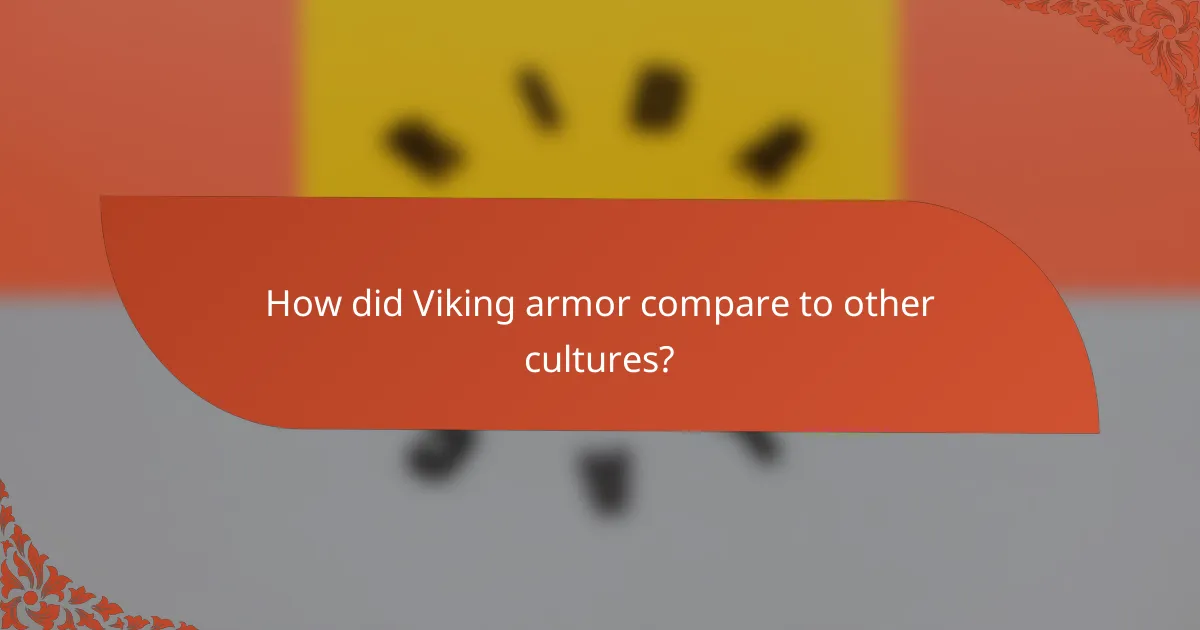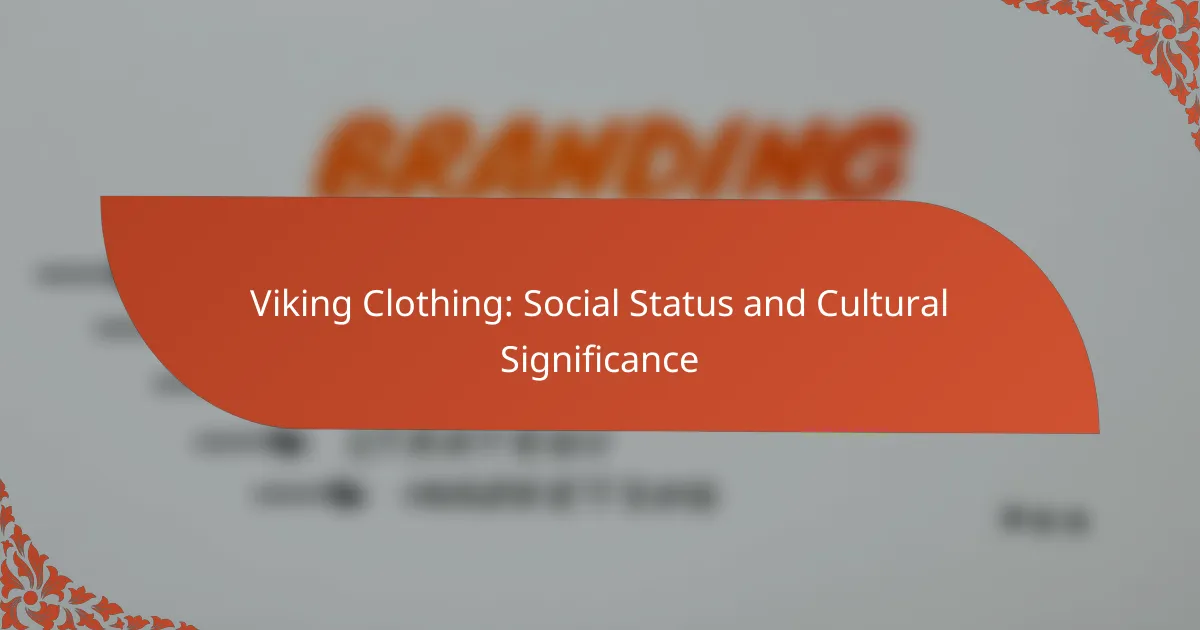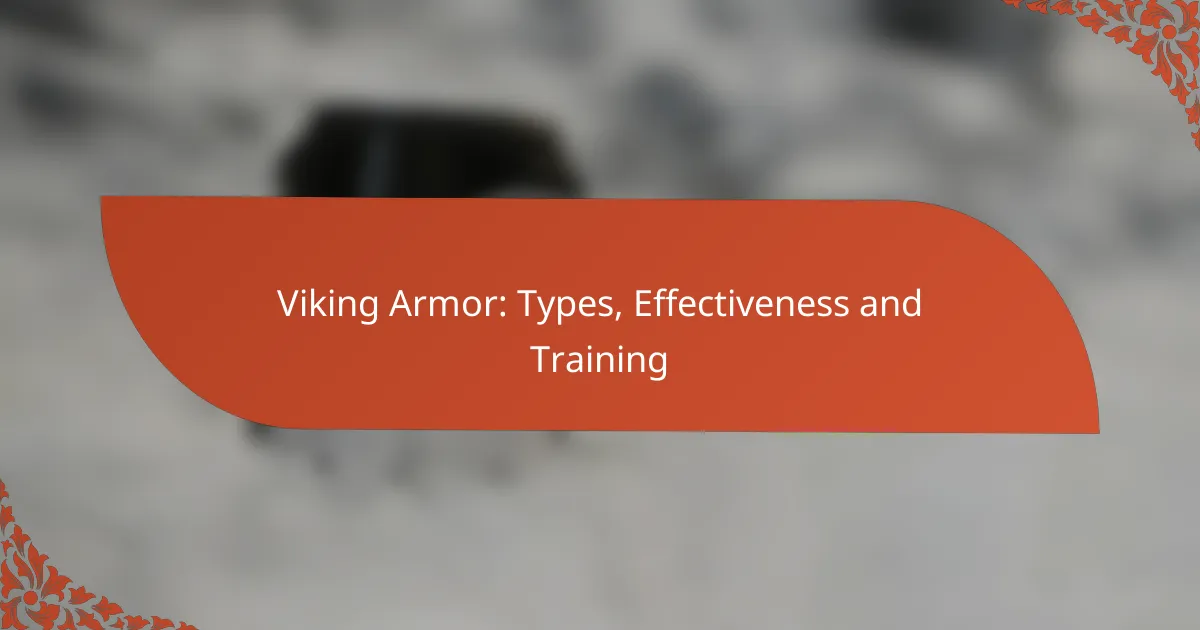Viking armor played a crucial role in the protection and effectiveness of Norse warriors, featuring a variety of designs such as chainmail shirts, leather armor, and scale armor. Over time, these armaments evolved from simple materials to more sophisticated metal constructions, driven by technological advancements and the changing nature of warfare. Helmets with nasal guards and uniquely crafted shields further enhanced the combat readiness of these formidable fighters.

What types of Viking armor were used in Scandinavia?
Viking armor in Scandinavia primarily consisted of chainmail shirts, leather armor, scale armor, helmets with nasal guards, and uniquely designed shields. Each type offered varying levels of protection and was suited to different combat scenarios.
Chainmail shirts
Chainmail shirts, or hauberks, were a popular choice among Vikings for their flexibility and protection. Made from interlinked metal rings, they provided a robust defense against slashing attacks while allowing for mobility. These shirts typically covered the torso and sometimes extended to the thighs, with sleeves varying in length.
While effective, chainmail was labor-intensive to produce, often requiring thousands of rings. Consequently, they were more common among wealthier warriors, with costs reflecting the craftsmanship involved.
Leather armor
Leather armor was another common type of protection used by Vikings, often made from animal hides. It was lighter than chainmail and offered decent protection against cuts and blows. Leather armor could be reinforced with metal plates or scales for added defense, making it versatile for different combat situations.
Due to its availability and ease of production, leather armor was accessible to a broader range of warriors. However, it was less effective against piercing weapons compared to metal armors.
Scale armor
Scale armor consisted of small overlapping plates, usually made from metal or hardened leather, sewn onto a backing material. This design provided excellent protection while maintaining flexibility, making it suitable for both infantry and cavalry. Scale armor was particularly effective against slashing attacks and could absorb impact well.
Although less common than chainmail, scale armor was favored for its unique combination of durability and weight. It required skilled craftsmanship, which influenced its availability among different social classes.
Helmets with nasal guards
Viking helmets typically featured nasal guards, which protected the face while allowing for good visibility. These helmets were often made of iron and sometimes included additional features like cheek plates for extra defense. The nasal guard design became iconic, symbolizing Viking warrior culture.
While helmets provided essential protection, they were not universally worn by all warriors, as they could be costly and heavy. However, those who wore them gained a significant advantage in battle.
Shields with unique designs
Viking shields were not only functional but also served as a canvas for personal expression, often featuring unique designs and colors. Made from wood and reinforced with metal rims, these shields were lightweight and easy to maneuver. The round shape allowed for effective blocking and deflection of attacks.
Shields were typically painted with symbols or patterns that represented the warrior’s clan or personal achievements. This added a psychological element to combat, as the visual impact could intimidate opponents.

How did Viking armor evolve over time?
Viking armor evolved significantly from simple leather designs to more complex metal constructions, reflecting advancements in technology and changes in warfare. This evolution was influenced by various factors, including trade, cultural exchanges, and the need to adapt to new battlefield tactics.
Transition from leather to metal
The earliest Viking armor primarily consisted of leather, which provided basic protection but was limited in durability and effectiveness against weapons. As time progressed, Vikings began incorporating metal elements, such as chainmail and plate armor, which offered superior defense against slashing and piercing attacks.
By the late Viking Age, many warriors wore a combination of leather and metal, with chainmail shirts becoming increasingly common. This transition marked a significant improvement in the survivability of Viking fighters during raids and battles.
Influence of trade with other cultures
Trade routes established by Vikings facilitated cultural exchanges that significantly impacted armor design. Contact with the Byzantine Empire and the Islamic world introduced new materials and techniques, such as the use of tempered steel for blades and armor.
These interactions led to the adoption of more sophisticated armor styles, including the use of decorative elements and improved craftsmanship. As a result, Viking armor became not only more functional but also a symbol of status and wealth among warriors.
Adaptation to battlefield tactics
Viking warfare tactics evolved, necessitating changes in armor design. Initially, Vikings relied on shock tactics and swift raids, which required lighter armor for mobility. However, as they faced more organized armies, heavier armor became essential for protection during prolonged engagements.
By adapting their armor to suit different combat scenarios, Vikings were able to maintain their effectiveness on the battlefield. This adaptability ensured that their armor remained relevant as warfare techniques continued to develop throughout the Viking Age.

What were the key features of Viking helmets?
Viking helmets were primarily characterized by their conical shape, sturdy construction, and protective features. They often included a faceguard or nasal piece to shield the wearer during combat.
Materials used in construction
Viking helmets were typically made from iron or bronze, materials chosen for their strength and availability. The iron was often sourced locally, while bronze could be imported, reflecting trade connections. Some helmets featured decorative elements made from leather or cloth for added comfort and style.
Design variations across regions
Design variations of Viking helmets were influenced by regional practices and available resources. For instance, helmets from Scandinavia often had a more simplistic design, while those found in areas with greater trade influence, like the British Isles, displayed more elaborate features. The differences could also reflect the specific needs of the warriors in those regions.
Significance of horned helmets myth
The myth of horned helmets is largely a modern misconception, as historical evidence suggests that Vikings did not wear such helmets in battle. The image of horned helmets was popularized in the 19th century through art and literature, creating a lasting but inaccurate stereotype. Understanding this myth helps clarify the true nature of Viking armor and its practical design.

How did Viking armor compare to other cultures?
Viking armor was distinct in its design and functionality, often prioritizing mobility over heavy protection compared to other cultures. While it shared some similarities with contemporary armors, it also exhibited unique features that reflected the Vikings’ combat style and environment.
Comparison with Anglo-Saxon armor
Viking armor and Anglo-Saxon armor both utilized chainmail and helmets, but there were notable differences in construction and materials. Anglo-Saxon warriors often wore more layered and heavier armor, which provided better protection but limited mobility. In contrast, Vikings favored lighter designs that allowed for greater agility in battle.
Additionally, while Anglo-Saxon helmets were typically more ornate, Viking helmets were often simpler and more functional, focusing on practicality. This difference in design reflects the varying combat strategies and cultural values of the two groups.
Differences from Byzantine armor
Byzantine armor was characterized by its use of elaborate and heavy materials, including scale armor and lamellar designs, which offered superior protection. In contrast, Viking armor was generally less complex and lighter, emphasizing mobility over maximum defense. This made Viking warriors more agile on the battlefield, which was crucial for their hit-and-run tactics.
Furthermore, Byzantine armor often included decorative elements that signified rank and status, while Viking armor was typically more utilitarian, focusing on effectiveness in combat rather than aesthetics.
Influence of Frankish designs
Frankish armor had a significant impact on Viking designs, particularly in the adoption of certain helmet styles and the use of chainmail. The Vikings incorporated elements from Frankish armor, such as the nasal helmet, which provided better facial protection without sacrificing visibility.
This exchange of ideas illustrates the interconnectedness of cultures during the Viking Age, as trade and warfare facilitated the sharing of military innovations. The influence of Frankish designs helped Vikings enhance their armor while maintaining their distinctive combat approach.

What role did armor play in Viking society?
Armor was crucial in Viking society, serving both practical and symbolic purposes. It protected warriors in battle while also signifying their status and wealth within the community.
Symbol of status and wealth
In Viking culture, armor was often a reflection of a warrior’s social standing. High-quality materials like iron and bronze were used in crafting armor, and the more elaborate the design, the higher the status it conveyed.
Wealthy individuals could afford ornate helmets and chainmail, while common warriors typically wore simpler gear. This distinction in armor not only indicated rank but also influenced a warrior’s reputation on the battlefield.
Impact on warfare strategies
Armor influenced Viking warfare strategies by allowing for more aggressive tactics. Heavily armored warriors could engage in close combat, leading to a more confrontational style of fighting.
Additionally, the type of armor worn affected the formation and movement of troops during raids. For instance, lighter armor allowed for greater mobility, which was advantageous in surprise attacks or quick retreats.
Representation in Viking sagas
Viking sagas often depict armor as a symbol of heroism and valor. These narratives highlight the importance of a warrior’s gear in battles, showcasing how it contributed to their legendary status.
Armor is frequently described in detail, emphasizing its craftsmanship and the pride warriors took in their equipment. This representation not only reflects the historical significance of armor but also reinforces the cultural values of bravery and honor in Viking society.

What are modern interpretations of Viking armor?
Modern interpretations of Viking armor often blend historical accuracy with practical considerations for reenactment and display. These interpretations typically include chainmail, leather, and plate elements, reflecting the styles and materials believed to be used by Vikings during their time.
Reenactment groups in Europe
Reenactment groups across Europe focus on accurately portraying Viking life, including the use of armor. These groups often conduct extensive research to replicate the designs and materials of historical armor, ensuring authenticity in their presentations.
Participants in these groups may invest in custom-made armor or modify existing pieces to align with historical standards. Common materials include steel for helmets and chainmail, while leather is frequently used for tunics and protective gear.
Many reenactment events feature battles and demonstrations that showcase the effectiveness and appearance of Viking armor. Groups often collaborate with historians to refine their techniques and improve the educational value of their displays.









